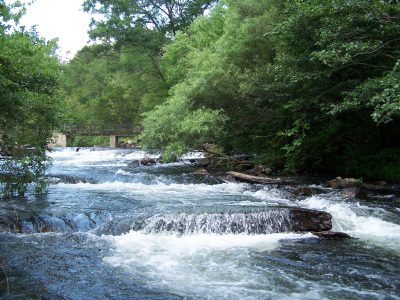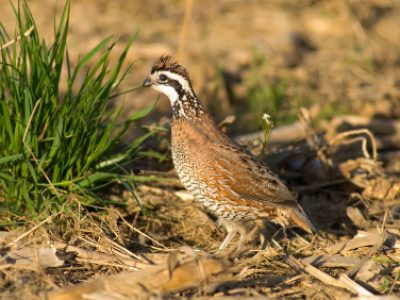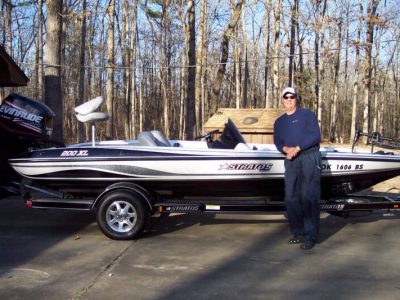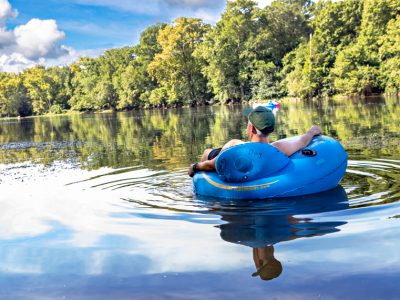When it comes to hunting wild turkey, the Honobia Creek and Three Rivers Wildlife Management Areas (WMAs) should not be overlooked. These two WMAs offer more than 330,000-acres of eastern wild turkey hunting action with an average of 270 adult male gobblers harvested from the WMAs annually. The eastern wild turkey is widely known for its elusive and skittish behavior, but that toughness just makes it that much more rewarding when harvesting a gobbler. Planning ahead and doing some pre-season scouting can often be the key to harvesting a bird for the dinner table.
The habitat of the Honobia Creek and Three Rivers WMAs is great for eastern wild turkey and consists of hardwood dominated ridges, creeks, and bottomland areas interspersed among commercially managed loblolly pine plantations between one and 30 years old. Knowing a little about the lay of the land is always beneficial when it comes to choosing a nice spot to scout for wild turkey sign. Aerial photographs and topographic maps will aid in seeing what’s out there before actually visiting the WMAs. Maps of the WMAs including aerial photographs and topographic maps are available by visiting www.wildlifedepartment.com.
A great place to consider checking into is any of the three walk-in only turkey hunting areas on the WMAs. All three are intensively managed for the benefit of wild turkey by eliminating vehicle disturbance through the crucial nesting and brood rearing seasons. Additionally, biologists focus other habitat manipulation practices in these walk-in areas including prescribed burning, mowing and discing, protecting hardwood areas and travel corridors, seeding old roads, and through the construction of timber openings and habitat enhancement plots. Each walk-in area has its own unique habitat characteristics which just add to their value for wild turkey and other wildlife.
When scouting a specific hunting location, pay particular attention snags, downed timber, log piles, thick brush, creeks, or anything that may be an obstacle to an approaching gobbler. Remember, during the spring, gobblers focus their attention on hens and hens tend to choose areas where food, such as early season grasses, and suitable nesting habitat is available. On the WMAs, early season grasses and preferred nesting habitat are found in or near natural openings, along less-traveled logging roads, and near habitat enhancement plots. If gobblers are in the area, fresh strut marks may be present in the roadway. In pine plantation forested habitats such as is present on the WMAs, turkeys can be found in areas with a higher proportion of different habitat types all in close proximity to each other such as a mature pine stand bordering a two year old pine stand, both near a large area of oak-hickory dominated timber. Many a large gobbler has been harvested by hunters setting up their decoy spread along a mature pine and young pine plantation boundary.
Turkey hunters know that early in the spring turkey season gobblers tend to be “henned up” and rarely found by themselves or in small male groups. Gobblers surrounded by hens can often be difficult to call in within shooting distance. Determining where gobblers are roosting and where they will head when coming off the roost to meet up with hens can help overcome this. Quietly setting up before daylight between the gobblers roost position and where he plans to head once coming off the roost will often allow a shot as he travels between the two sites. Later in the day and especially as the spring turkey season begins to wind down, hens will begin to abandon the males and attend to their nest. These abandoned males often get lonely for another hen and present a good opportunity to call in mid-day.
There are a wide variety of turkey calls on the market made from many different types of wood and materials. Many hunters carry more than one type of call while in the woods and often two or three calls all alike but made from different types of materials. Whether using box calls, slate calls, or mouth calls, having more than one to choose from does help. Some gobblers may not respond at all to calls from a box call, but will gobble in response to a slate or mouth call. In addition, a slate call made from cherry wood with an aluminum striker will sound different than a slate call made from black walnut and struck with a plexiglass striker. Every hunter has different preferences and spending time experimenting with many different types of calls and how they are best used in various hunting situations is important. Sometimes the best tactic to use especially when hunting eastern wild turkey is not calling at all. Gobblers often hang up if they think that a hen is moving toward his location and not calling at all will make him think that he needs to head toward her. Eastern turkeys also tend to come to calls silently fooling even the most experienced hunters into giving up too early and spooking the bird as he was quietly approaching.
The spring turkey season on the Honobia Creek and Three Rivers WMAs generally runs from April 6 to May 6 each year, but be sure to consult the Oklahoma Hunting Guide before planning a spring turkey hunting visit to the WMAs. For the serious turkey hunter, harvesting an eastern wild turkey during the fall is allowed on the WMAs using archery equipment only from October 1 through January 15.
The Honobia Creek and Three Rivers WMAs are privately owned by timber companies, but open to the public through cooperative agreements between the Oklahoma Department of Wildlife Conservation and each timber company. Accessing the Honobia Creek and Three Rivers WMAs for any type of recreation does require each person to purchase a Land Access Fee permit. The permit, $40 for Oklahoma residents between the ages of 18 and 64 and $85 for nonresidents (no age exemptions for nonresidents), is good for one calendar year and is sold at all locations in Oklahoma that sell hunting and fishing licenses. All revenue from each Land Access Fee permit sold goes not only toward the management of the WMAs, but also to pay the timber investment companies an annual lease fee to help keep the WMAs open for the public to enjoy.
Feel free to contact the Honobia Creek and Three Rivers Wildlife Management Area biologist at 918-527-5308 before planning your next hunting trip to the Honobia Creek and Three Rivers WMAs.








